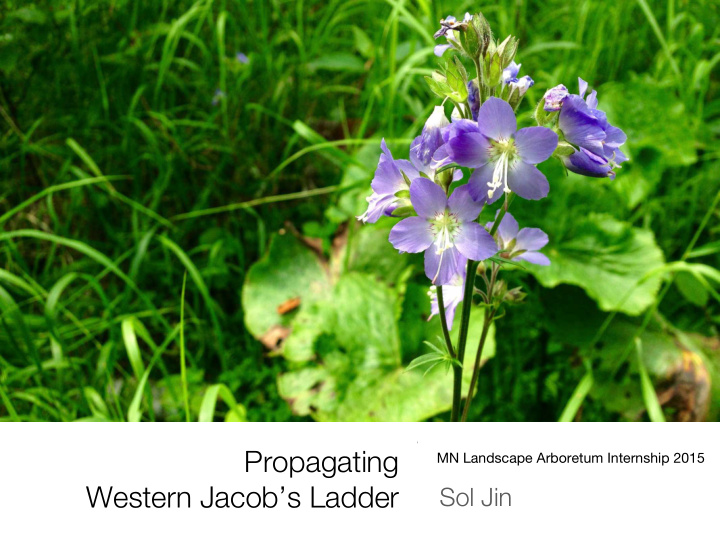



Propagating MN Landscape Arboretum Internship 2015 Western Jacob’s Ladder Sol Jin
Background Information • Western Jacob’s Ladder (Polemonium occidentale ssp. lacustre) • Perennial :: Dicot • Habitat • Plant Characteristics • USDA: Endangered: species in danger of extinction • Reason for this project: Plant Conservation and Restoration
Known Locations North Central Forest
Objective • To germinate seeds and observe seedling growth of Western Jacob’s Ladder on different media in order to determine future planting location at the Arboretum • Hypothesis: different media will have different affects on the growth of WJL. Difference may be caused by soil characteristics like pH. • Tasks • Germination trials • Phenology study: Leaf count and height measurement • Testing soil samples
Germination • 2 collections —> April and June • Protocol 1. 100 seeds from two populations: Polemonium Bog and Alborn 30 2. 10 seeds each on ten plates with thick filter paper in 2” plates 3. Spray with PPM (plant preservative mixture) until damp 4. Wrap with Parafilm
April Germination • Polemonium Bog: 7/94 seeds — 7% • Alborn 30: 64/98 seeds — 65% • Planted into Pro-mix with thin sphagnum on top • Successful Seedling Growth Polemonium Bog: 3/7 • Alborn 30: 46/64 •
Three Treatments Sphagnum+ Bark: 20 plants Pro-mix: 19 plants Acidic: 10 plants
June Germination • Bleached and plated with PPM • Polemonium Bog: 6/102 seeds —6% • Alborn 30: 48/103 seeds — 47% • Divided and planted into Pro- mix and Sphagnum + Bark soil • Successful Seedling Growth • Polemonium Bog: 0/6 • Alborn 30: 35/48
Germination: Fresh Planting • 20 PB seeds kept in the fridge for 37 days in moist condition • Planted into Pro-mix and 1 cm sphagnum moss at the top • 0% growth
Observation on Phenology Height measurement and plant leaf calculation �
Plant Growth and Observations • WJL in Pro-mix grew faster and larger compared to the others • plants started to spread with rhizomes • Stems turned purple, probably due to water pH • roots grew out of pots and leaves were withering: Transplanted into 4” pots in 42days
May 26 Acidic Soil Aug 6
May 26 Sphagnum and Bark Aug 6
May 26 Pro-mix Aug 6
Flowering: 7/22/15 • After 105days since its germination, a flower bud appeared!! • Reference: stalk should have been 27.5inch. • Started to flower at 11 inches
7.29.15 8.3.15
Conclusion: pH Level Compared (ppm unit) pH level NH4 Ca Mg B P Green Heron 6.3 22.3 2700.9 781.2 2.2 22.3 Bog Polemonium 6.7 14.8 1804.7 295.9 0.7 <1 Bog Pro-mix 6.4 21.2 3389.8 466.1 0.6 105.9 Acidic 4.7 34.5 517.2 206.9 1.7 17.2 Sphagnum+ 4.6 161.3 1129.0 403.2 2.4 80.6 Bark
Conclusion • A30 had greater seed viability than PB: important to know for future seed banking • WJL grew tallest and produced most leaf growth in Pro- mix, hence, Pro-mix is the best nursery soil for young WJL. • PM and PB had similar pH and other soil characteristics; hence, WJL should do well on Arb. Bog • My recommendation is planting WJL in the Bog soon this summer.
Reference Schmidt, Lori. “Conservation Assessment for Polemonium Occidentale v. • lacustre Western Jacob’s Ladder.” September, 2003. PDF file. "Soils - Part 6: Phosphorus and Potassium in the Soil." Plant and Soil • Sciences ELibrary . N.p., n.d. Web. 17 Aug. 2015. Western Jacob's Ladder (Polemonium Occidentale Ssp. Lacustre) . • Wisconsin Department of Natural Resources, 14 July 2015. Web. 11 Aug. 2015. Wisconsin Departments of Natural Resources. “Status of Polemonium • Occidentale ssp. Lacustre in Wisconsin and Minnesota 1992-1997.” March 1998. PDF file.
Recommend
More recommend